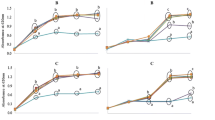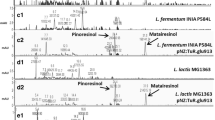Abstract
Lignans are ubiquitous plant polyphenols, which have relevant health properties being the major phytoestrogens occurring in Western diets. Secoisolariciresinol (SECO) is the major dietary lignan mostly found in plants as secoisolariciresinol diglucoside (SDG). To exert biological activity, SDG requires being deglycosylated to SECO and transformed to enterodiol (ED) and enterolactone (EL) by the intestinal microbes. The involvement of bifidobacteria in the transformation of lignans glucosides has been investigated for the first time in this study. Twenty-eight strains were assayed for SDG and SECO activation. They all failed to transform SECO into reduced metabolites, excluding any role in ED and EL production. Ten Bifidobacterium cultures partially hydrolyzed SDG, giving both SECO and the monoglucoside with yields < 25%. When the cell-free extracts were assayed in SDG transformation, seven additional strains were active in the hydrolysis. Cellobiose induced β-glucosidase activity and caused the enhancement of both the rate of SDG hydrolysis and the final yield of SECO only in the strains capable of SDG bioconversion. The highest SDG conversion to SECO was achieved by Bifidobacterium pseudocatenulatum WC 401, which exhibited 75% yield in cellobiose-based medium after 48 h. These results indicate that SDG hydrolysis is not a common feature in Bifidobacterium genus, but selected probiotic strains can be combined to β-glucoside-based prebiotics to enhance the release of SECO, thus improving its bioavailability for absorption by colonic mucosa and/or the biotransformation to ED and EL by other intestinal microorganisms.




Similar content being viewed by others

References
Adams LS, Chen S (2009) Phytochemicals for breast cancer prevention by targeting aromatase. Front Biosci 14:3846–3863
Adlercreutz H (2007) Lignans and human health. Crit Rev Clin Lab Sci 44:483–525
Adolphe JL, Whiting SJ, Juurlink BH, Thorpe LU, Alcorn J (2010) Health effects with consumption of the flax lignan secoisolariciresinol diglucoside. Br J Nutr 103:929–938
Amaretti A, Tamburini E, Bernardi T, Pompei A, Zanoni S, Vaccari G, Matteuzzi D, Rossi M (2006) Substrate preference of Bifidobacterium adolescentis MB 239: compared growth on single and mixed carbohydrates. Appl Microbiol Biotechnol 73:654–662
Bommareddy A, Arasada BL, Mathees DP, Dwivedi C (2006) Chemopreventive effects of dietary flaxseed on colon tumor development. Nutr Cancer 54:216–222
Brooks JD, Thompson LU (2005) Mammalian lignans and genistein decrease the activities of aromatase and 17β-hydroxysteroid dehydrogenase in MCF-7 cells. J Steroid Biochem Mol Biol 94:461–467
Clavel T, Doré J, Blaut M (2006a) Bioavailability of lignans in human subjects. Nutr Res Rev 19:187–196
Clavel T, Henderson G, Engst W, Doré J, Blaut M (2006b) Phylogeny of human intestinal bacteria that activate the dietary lignan secoisolariciresinol diglucoside. FEMS Microbiol Ecol 55:471–478
Dabek M, McCrae SI, Stevens VJ, Duncan SH, Louis P (2008) Distribution of β-glucosidase and β-glucuronidase activity and of β-glucuronidase gene gus in human colonic bacteria. FEMS Microbiol Ecol 66:487–495
Desjardins ML, Roy D, Goulet J (1989) Growth of bifidobacteria and their enzyme profiles. J Dairy Sci 73:299–307
Donkor ON, Shah NP (2008) Production of beta-glucosidase and hydrolysis of isoflavone phytoestrogens by Lactobacillus acidophilus, Bifidobacterium lactis, and Lactobacillus casei in soymilk. J Food Sci 73:M15–M20
Eckburg PB, Bik EM, Bernstein CN, Purdom E, Dethlefsen L, Sargent M, Gill SR, Nelson KE, Relman DA (2005) Diversity of the human intestinal microbial flora. Science 308:1635–1638
Eeckhaut E, Struijs K, Possemiers S, Vincken JP, Keukeleire DD, Verstraete W (2008) Metabolism of the lignan macromolecule into enterolignans in the gastrointestinal lumen as determined in the simulator of the human intestinal microbial ecosystem. J Agric Food Chem 56:4806–4812
Ford JD, Huang KS, Wang HB, Davin LB, Lewis NG (2001) Biosynthetic pathway to the cancer chemopreventive secoisolariciresinol diglucoside-hydroxymethyl glutaryl ester-linked lignan oligomers in flax (Linum usitatissimum) seed. J Nat Prod 64:1388–1397
Giada Mde L (2010) Food applications for flaxseed and its components: products and processing. Recent Pat Food Nutr Agric 2:181–186
Hawkesworth G, Drasar BS, Hill MJ (1971) Intestinal bacteria and the hydrolysis of glycosidic bonds. J Med Microbiol 4:451–459
Juurlink BHJ (2001) Therapeutic potential of dietary phase 2 enzyme inducers in ameliorating diseases that have an underlying inflammatory component. Can J Physiol Pharmacol 79:266–282
Kitts DD, Yuan YV, Wijewickreme AN, Thompson LU (1999) Antioxidant activity of the flaxseed lignan secoisolariciresinol diglycoside and its mammalian lignan metabolites enterodiol and enterolactone. Mol Cell Biochem 202:91–100
Li X, Yuan JP, Xu SP, Wang JH, Liu X (2008) Separation and determination of secoisolariciresinol diglucoside oligomers and their hydrolysates in the flaxseed extract by high-performance liquid chromatography. J Chromatogr A 1185:223–232
Manach C, Scalbert A, Morand C, Rémésy C, Jiménez L (2004) Polyphenols: food sources and bioavailability. Am J Clin Nutr 79:727–747
Marazza JA, Garro MS, de Giori GS (2009) Aglycone production by Lactobacillus rhamnosus CRL981 during soymilk fermentation. Food Microbiol 26:333–339
Marotti I, Bonetti A, Biavati B, Catizone P, Dinelli G (2007) Biotransformation of common bean (Phaseolus vulgaris L.) flavonoid glycosides by Bifidobacterium species from human intestinal origin. J Agric Food Chem 55:3913–3919
Milder IE, Arts IC, van de Putte B, Venema DP, Hollman PC (2005) Lignan contents of Dutch plant foods: a database including lariciresinol, pinoresinol, secoisolariciresinol and matairesinol. Br J Nutr 93:393–402
Moutsatsou P (2007) The spectrum of phytoestrogens in nature: our knowledge is expanding. Hormones (Athens) 6:173–193
Mueller SO, Simon S, Chae K, Metzler M, Korach KS (2004) Phytoestrogens and their human metabolites show distinct agonistic and antagonistic properties on estrogen receptor alpha (ERalpha) and ERbeta in human cells. Toxicol Sci 80:14–25
Peterson J, Dwyer J, Adlercreutz H, Scalbert A, Jacques P, McCullough ML (2010) Dietary lignans: physiology and potential for cardiovascular disease risk reduction. Nutr Rev 68:571–603
Prasad K (1999) Reduction of serum cholesterol and hypercholesterolemic atherosclerosis in rabbits by secoisolariciresinol diglucoside isolated from flaxseed. Circulation 99:1355–1362
Prasad K (2001) Secoisolariciresinol diglucoside from flaxseed delays the development of type 2 diabetes in Zucker rat. J Lab Clin Med 138:32–39
Prasad K (2009) Flaxseed and cardiovascular health. J Cardiovasc Pharmacol 54:369–377
Raimondi S, Roncaglia L, De Lucia M, Amaretti A, Leonardi A, Pagnoni UM, Rossi M (2009) Bioconversion of soy isoflavones daidzin and daidzein by Bifidobacterium strains. Appl Microbiol Biotechnol 81:943–950
Rajilić-Stojanović M, Smidt H, de Vos WM (2007) Diversity of the human gastrointestinal tract microbiota revisited. Environ Microbiol 9:2125–2136
Rossi M, Amaretti A (2010) Probiotics properties of bifidobacteria. In: Mayo B, van Sinderen D (eds) Bifidobacteria—genomics and molecular aspects. Caister Academic, Norfolk, pp 97–123
Rossi M, Amaretti A, Roncaglia L, Leonardi A, Raimondi S (2010) Dietary isoflavones and intestinal microbiota: metabolism and transformation into bioactive compounds. In: Thomson MJ (ed) Isoflavones: biosynthesis, occurrence and health effects. Nova Science, Hauppauge, pp 137–161
Rowland I, Faughnan M, Honey L, Wähälä K, Williamson G, Cassidy A (2003) Bioavailability of phyto-oestrogens. Br J Nutr 89:S45–S58
Saarinen NM, Wärri A, Airio M, Smeds A, Mäkelä S (2007) Role of dietary lignans in the reduction of breast cancer risk. Mol Nutr Food Res 51:857–866
Smeds AI, Eklund PC, Sjöholm RE, Willför SM, Nishibe S, Deyama T, Holmbom BR (2007) Quantification of a broad spectrum of lignans in cereals, oilseeds, and nuts. J Agric Food Chem 55:1337–1346
Struijs K, Vincken JP, Gruppen H (2009) Bacterial conversion of secoisolariciresinol and anhydrosecoisolariciresinol. J Appl Microbiol 107:308–317
Swedenborg E, Power KA, Cai W, Pongratz I, Rüegg J (2009) Regulation of estrogen receptor beta activity and implications in health and disease. Cell Mol Life Sci 66:3873–3894
Tsangalis D, Ashton JF, McGill AEJ, Shah NP (2002) Enzymatic transformation of isoflavone phytoestrogens in soymilk by β-glucosidase-producing bifidobacteria. J Food Sci 67:3104–3113
Tsangalis D, Ashton JF, McGill AEJ, Shah NP (2003) Biotransformation of isoflavones by bifidobacteria in fermented soymilk supplemented with d-glucose and l-cysteine. J Food Sci 68:623–631
Venema K (2010) Role of gut microbiota in the control of energy and carbohydrate metabolism. Curr Opin Clin Nutr Metab Care 13:432–438
Wang W, Liu LQ, Higuchi CM, Chen H (1998) Induction of NADPH:quinone reductase by dietary phytoestrogens in colonic Colo205 cells. Biochem Pharmacol 56:189–195
Williams NT (2010) Probiotics. Am J Health-Syst Pharm 67:449–458
Wong JM, de Souza R, Kendall CW, Emam A, Jenkins DJ (2007) Colonic health: fermentation and short chain fatty acids. J Clin Gastroenterol 40:235–243
Woting A, Clavel T, Loh G, Blaut M (2010) Bacterial transformation of dietary lignans in gnotobiotic rats. FEMS Microbiol Ecol 72:507–514
Yuan JP, Li X, Xu SP, Wang JH, Liu X (2008) Hydrolysis kinetics of secoisolariciresinol diglucoside oligomers from flaxseed. J Agric Food Chem 56:10041–10047
Zhang W, Wang X, Liu Y, Tian H, Flickinger B, Empie MW, Sun SZ (2008a) Effects of dietary flaxseed lignan extract on symptoms of benign prostatic hyperplasia. J Med Food 11:207–214
Zhang W, Wang X, Liu Y, Tian H, Flickinger B, Empie MW, Sun SZ (2008b) Dietary flaxseed lignan extract lowers plasma cholesterol and glucose concentrations in hypercholesterolaemic subjects. Br J Nutr 99:1301–1309
Zoetendal EG, Rajilic-Stojanovic M, de Vos WM (2008) High-throughput diversity and functionality analysis of the gastrointestinal tract microbiota. Gut 57:1605–1615
Conflicts of interest
The authors declare that they have no conflicts of interest.
Author information
Authors and Affiliations
Corresponding author
Rights and permissions
About this article
Cite this article
Roncaglia, L., Amaretti, A., Raimondi, S. et al. Role of bifidobacteria in the activation of the lignan secoisolariciresinol diglucoside. Appl Microbiol Biotechnol 92, 159–168 (2011). https://doi.org/10.1007/s00253-011-3338-8
Received:
Revised:
Accepted:
Published:
Issue Date:
DOI: https://doi.org/10.1007/s00253-011-3338-8



